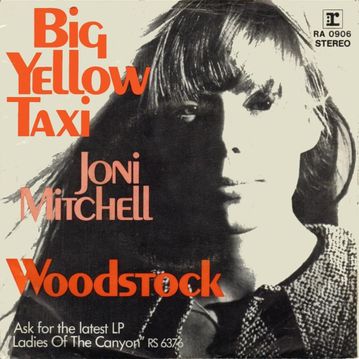 | Big Yellow TaxiJoni Mitchell |
Writer(s): Joni Mitchell (see lyrics here) First Charted: June 6, 1970 Peak: 24 BB, 100 CB, 35 GR, 32 HR, 33 AC, 3 CL, 11 UK, 14 CN, 6 AU, 3 DF (Click for codes to charts.) Sales (in millions): -- US, 0.4 UK, 0.48 world (includes US + UK) Airplay/Streaming (in millions): 1.0 radio, 18.5 video, 170.30 streaming |
Awards:Click on award for more details. |
About the Song:Folk singer/songwriter Joni Mitchell was born Roberta Joan Anderson in Alberta, Canada, in 1943. She moved to the United States in 1965, eventually settling in Laurel Canyon, a Los Angeles neighborhood which became known as a haven for the counterculture movement and a launching pad for multiple musicians in the mid-‘60s through the mid-‘70s. She released her first album, Song to a Seagull, in 1968. Joni’s third album, 1970’s Ladies of the Canyon, reached the top 30 on the Billboard album chart and went platinum. The title was a reference to Laurel Canyon and included some of her most notable songs such as “Woodstock,” “The Circle Game,” and “Big Yellow Taxi.” The latter “combines the global and the personal in a playful, jaunty song that nonetheless makes its point.” TC She explained how the song was inspired by a visit to Hawaii. She said, “The hotel room was quite high up so in the distance I could see the blue Pacific Ocean. I walked over to the balcony and there was the picturebook scenery, palm tree swaying in the breeze and all. Then I looked down and there was this ugly concrete car park,” TC which, as she said in another interview, “as far as the ey could see…and it broke my heart…this blight on paradise.” DT She came up with the line “They paved paradise and put up a parking lot” and the song was born. Another famous line from the song was “They took all the trees, and put ‘em in a tree museum / And charged the people a dollar and a half just to see ‘em.” It was inspired by Foster Botanical Garden, a living museum of tropical plants in Honolulu. WK The song takes a personal turn toward then end when Mitchell refers to a loved one leaving in a a big yellow taxi. Some have interpreted it as him walking out on her while others think it could mean he was being taken away by the authorities. WK The studio version of the song was released as a single in 1970, but peaked at #67 on the Billboard Hot 100. Four years later, a live version outdid the original, climbing to #24. The song would also be a hit for the Neighborhood (#29 BB, 1970), Amy Grant (1994, #67 BB, 18 AC, 20 UK, 25 CN), and the Counting Crows with Vanessa Carlton (2002, #42 BB, 5 AC, 16 UK, 12 CN, 3 AU). Resources:
Related Links:First posted 4/25/2024. |








No comments:
Post a Comment